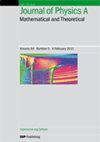Projected state ensemble of a generic model of many-body quantum chaos
IF 2.1
3区 物理与天体物理
Q2 PHYSICS, MATHEMATICAL
Journal of Physics A: Mathematical and Theoretical
Pub Date : 2024-09-16
DOI:10.1088/1751-8121/ad7211
引用次数: 0
Abstract
The projected ensemble is based on the study of the quantum state of a subsystem A conditioned on projective measurements in its complement. Recent studies have observed that a more refined measure of the thermalization of a chaotic quantum system can be defined on the basis of convergence of the projected ensemble to a quantum state design, i.e. a system thermalizes when it becomes indistinguishable, up to the kth moment, from a Haar ensemble of uniformly distributed pure states. Here we consider a random unitary circuit with the brick-wall geometry and analyze its convergence to the Haar ensemble through the frame potential and its mapping to a statistical mechanical problem. This approach allows us to highlight a geometric interpretation of the frame potential based on the existence of a fluctuating membrane, similar to those appearing in the study of entanglement entropies. At large local Hilbert space dimension q, we find that all moments converge simultaneously with a time scaling linearly in the size of region A, a feature previously observed in dual unitary models. However, based on the geometric interpretation, we argue that the scaling at finite q on the basis of rare membrane fluctuations, finding the logarithmic scaling of design times . Our results are supported with numerical simulations performed at q = 2.多体量子混沌通用模型的投影态集合
投影集合基于对子系统 A 的量子态的研究,其条件是对子系统 A 的补集进行投影测量。最近的研究发现,混沌量子系统热化的一个更精细的衡量标准可以在投影集合收敛到量子态设计的基础上定义,即当一个系统与均匀分布的纯态的哈尔集合在第 k 个时刻前变得不可区分时,该系统就热化了。在这里,我们考虑了一个具有砖墙几何形状的随机单元电路,并通过框架势及其与统计力学问题的映射,分析了它向哈尔集合的收敛。通过这种方法,我们可以强调基于波动膜存在的框架势的几何解释,这与纠缠熵研究中出现的情况类似。在较大的局部希尔伯特空间维度 q 下,我们发现所有时刻都会同时收敛,收敛时间与区域 A 的大小成线性比例,这是以前在对偶单元模型中观察到的特征。然而,基于几何解释,我们认为,在有限 q 的基础上的缩放是基于罕见的膜波动,发现了设计时间的对数缩放。我们的结果得到了在 q = 2 条件下进行的数值模拟的支持。
本文章由计算机程序翻译,如有差异,请以英文原文为准。
求助全文
约1分钟内获得全文
求助全文
来源期刊
CiteScore
4.10
自引率
14.30%
发文量
542
审稿时长
1.9 months
期刊介绍:
Publishing 50 issues a year, Journal of Physics A: Mathematical and Theoretical is a major journal of theoretical physics reporting research on the mathematical structures that describe fundamental processes of the physical world and on the analytical, computational and numerical methods for exploring these structures.

 求助内容:
求助内容: 应助结果提醒方式:
应助结果提醒方式:


